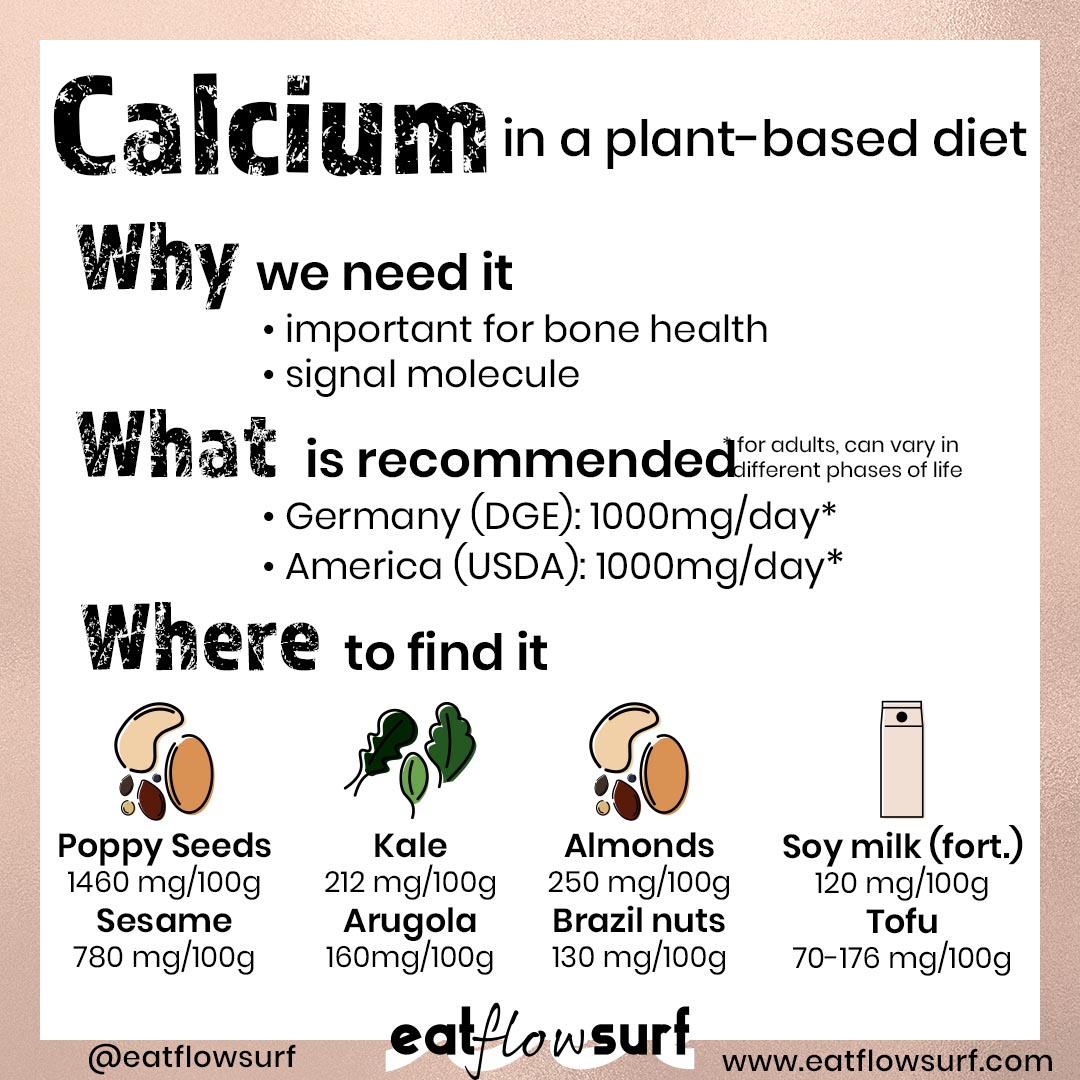Calcium is the micronutrient that most of us will instantly connect with milk and milkproducts, since this is what everyone (and every ad) tells us. But in reality, there are other foods that contain calcium and eating dairy does not guarantee an optimum intake.
So, do you know why calcium is important or how much we need? Does every non-vegan reach the requirements without problems? Let’s dive in.
Basics & Functions
Calcium plays a big role in bone health1, along with Vitamin D.
More than 99% of the calcium in our bodies lays in our bones and teeth, so it’s an important factor of bone density. A loss of calcium/not enough calcium in our diets can lead to lower bone density, which means weaker bones, that are more likely to break. This can then lead to osteoporosis (fragile bones), which affects mainly middle-aged and elderly persons, especially postmenopausal women2.
The peak bone mass is reached at around age 25-30, after that, a slow reduction of around 0.5-1.5% per year happens. Menopausal women tend to have a higher reduction (around 3.5% or more per year). It’s important to build up this basis with an adequate calcium intake, along with the right amount of vitamin D, physical activity and healthy lifestyle choices (abstaining from smoking and underage drinking)3.
Besides bone health, Calcium is an important signal molecule, e.g. for muscle contraction, release of insulin and certain neurotransmitters.
This is a very simplified summary, if you wnat to dive deeper, check out NutritionFacts.org, Harvard - School of Public health, NIH or for my fellow german speaking people ecodemy and DGE.
How the reach the recommendations
Recommondated calcium intake for adults is 1000 mg/day (Germany, DGE and America, USDA).
Vegans seem to not reach the recommendations, but also those that follow the typical western diet don’t reach it easily. Especially adolescent girls and elderly people don’t reach the recommendation (german NVS 2).
Though, the EPIC-Oxford study has shown that limited bone mineralization and an increased risk of fractures don’t seem to occur at calcium intakes higher than 525 mg/day.
With the following food sources, remember to keep the usual serving size in mind, e.g. one cup of soy milk is usually 200-250 ml, so the calcium content would be 240-300 mg/serving.
medium-calcium food sources
| Food | mg/100g |
|---|---|
| Almonds | 250 |
| Amaranth | 178-214 |
| Kale | 212 |
| Figs,dried | 190 |
| Tofu | 70 - 176 |
| Arugola | 160 |
| Brazil nuts | 130 |
| Hazelnuts | 114 |
| fortified soy milk | 120 |
high-calcium food sources
| Food | mg/100g |
|---|---|
| Poppy Seeds | 1460 |
| Sesame | 780 |
Ways to increase your calcium intake
-
Vitamin D helps to increase the absorption of calcium in the gut, so make sure you spend enough time in the sunlight or that you take a supplement (depending on the area you live).
-
You could also consume a fortified non-dairy milk/yoghurt to up your calcium intake (check the label for calcium content).
-
Tofu is also a good source of calcium.
-
(Mineral) water can help with achieving a higher daily calcium intake, but make sure to check the label, since the calcium content varies a lot.
-
You could lower the content of inhibitors like oxalates and phytates. These are natural components found in plants and can be beneficial for our health, but could also lead to a lower absorption of certain minerals. For example, phytate content can be lowered by soaking legumes and nuts. Oxalates are found in bigger concentrations only in certain vegetables like spinach and chard. There is no reason to completely avoid these, but you can be aware to include other vegetables into your diet.
-
There are also beneficial factors, that can increase the calcium absorption: Vitamin D (like said before), organic acids (like citric acid), eating calcium-rich foods throughout the day with different meals and certain amino acids.
Additionally, there a factors that promote renal excretion, e.g. increased protein intake, alcohol intake, increased phosphate intake and increased sodium intake.
Supplementation
Food sources are the best source for nutrients, but if that’s not possible, supplement only the deficit and in moderation (it’s best to talk to your doctor or a nutritionist before).
Multivitamins can contain calcium - so make sure to check the label if you’re taking one regularly.
A higher Dose than 400-500 mg/day should be avoided - and it’s important to know how much calcium you actually consume with your current diet.
Too much Calcium seems to be a health concern for cardiovascular health (increasing risk of heart attack and stroke4).
Final Words
Any questions? Write me an email or talk to me on social media ![]()
References
Some sources are already linked in the blogpost, but here are the additional sources I used (including german books):
Heike Englert, Sigrid Siebert (2016), Vegane Ernährung, 1. Auflage, UTB
Script from Ecodemy (VEA Ausbildung)
Hans Konrad Biesalski, Peter Grimm, Susanne Nowitzki-Grimm (2015), Taschenatlas Ernährung, 6. Auflage, Thieme
-
Flynn, Albert. “The Role of Dietary Calcium in Bone Health.” The Proceedings of the Nutrition Society 62, no. 4 (November 2003): 851–58. https://doi.org/10.1079/PNS2003301. ↩
-
Rusoff, L. L. “Calcium–Osteoporosis and Blood Pressure.” Journal of Dairy Science 70, no. 2 (February 1987): 407–13. https://doi.org/10.3168/jds.S0022-0302(87)80024-3. ↩
-
National Osteoporosis Foundation. “Peak Bone Mass.” Accessed November 8, 2019. https://www.nof.org/preventing-fractures/nutrition-for-bone-health/peak-bone-mass/. ↩
-
Reid, Ian R., Sarah M. Bristow, and Mark J. Bolland. “Cardiovascular Complications of Calcium Supplements.” Journal of Cellular Biochemistry 116, no. 4 (2015): 494–501. https://doi.org/10.1002/jcb.25028. ↩




